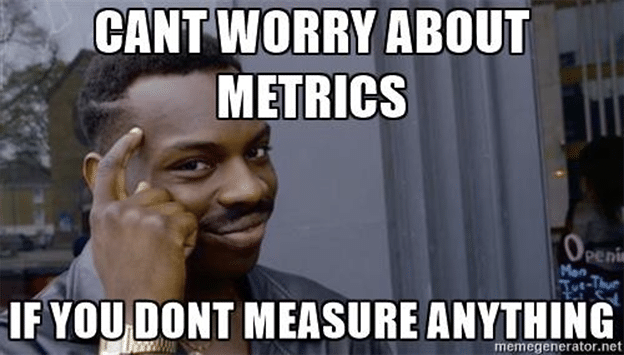Understanding the nuts and bolts of your funnel metrics isn’t just smart—it’s crucial. Let’s break down which metrics matter at each stage of your marketing funnel and how to keep tabs on what’s working – and most importantly, what’s not.
Sidenote – this is kinda a continuation of the previous blog on mapping content to each of the funnel stages so I’d encourage you to check that out first!
Why Funnel Metrics Matter:
We speak with brands of all sizes frequently and often find that CEOs of small-to-mid sized businesses particularly do not prioritize metrics tracking. Instead, they focus all their time on improving the service.
The question I ask is: “how do you know what to improve if you’re not tracking the engagement and drop-off points of the buyer’s journey?” – Mic drop.
Funnel Metrics are your reality check, showing you what’s flourishing, what’s bombing, and where you’re just burning cash. It’s equally important to note that not all metrics are valued equally!

I’m going to take you on a journey funnel-by-funnel and tell you exactly what needs to be tracked at each buyer stage.
Top of Funnel (TOFU) Metrics:
What to Track:
- Unique Website Visitors
- Traffic Volume by Channel
- Impressions
- Reach
- Likes
- Open Rates (though personally, I regard Open Rates as pretty misleading and useless in today’s age)
- Video Watch Time
- Downloads (though don’t expect many downloads at this stage)
- Branded Search Volume
- This includes your brand’s name in the keyword i.e. Kaze Creativez Branding or Kaze Creativez Content Marketing

Middle of Funnel (MOFU) Metrics:
What to Track:
- Time Spent on Website
- Pages Viewed Per Visit
- Comments, Shares and Bookmarks
- Click-Thru-Rates (CTR)
- Landing Page Visitors
- Bounce Rate
- Form Submissions
- Downloads / Lead Magnet Performance
- Email Replies
- Unsubscribe Rate
- Watch Time
- Organic Ranking Improvement
- Cart Abandonment (for eCommerce)
- Backlinks
- Earned Media
- List Growth Rate
Get a Free 60 minute strategy session
Bottom of Funnel (BOFU) Metrics:
What to Track:
- Cost Per Acquisition (CPA)
- Cost Per Lead (CPL)
- Average Class Attendance (must for fitness and wellness facilities)
- Average Order Value (must for eCommerce brands)
- Win Rate
- Trial to Conversion Rate (must for fitness apps and SaaS)
- Cost Per Install (must for fitness apps and SaaS)
Retention Metrics:
What to Track:
- Average Customer / Membership Lifetime Value (LTV / CLV)
- Repeat Purchase Ratio
- Net Promoter Score (NPS)
- Customer Churn Rate
5 (Free) Best Metric Tracking Tools
There are dozens and dozens of metrics tracking out there but here are some of my favorites, especially as they’re FREE.
Google Analytics (GA4)
- What it tracks: Website traffic, user behavior, conversion rates, and more.
- Why it’s useful: Google Analytics is the gold standard for free web analytics. It provides comprehensive insights into how users interact with your website and how your traffic correlates with your business goals.
Google Search Console (GSC)
- What it tracks: Website performance in Google search results, including branded and organic keywords, clicks, and ranking position.
- Why it’s useful: Google Search Console helps you understand your site’s visibility on Google, which pages are performing well, and where your SEO can be improved.
Hootsuite
- What it tracks: Allows scheduling posts and provides basic analytics for social media platforms.
- Why it’s useful: Hootsuite’s free plan offers basic tools for managing social media accounts, including tracking post performance and engagements across multiple social platforms.
Hotjar
- What it tracks: User behavior on your website via heatmaps, session recordings, and surveys.
- Why it’s useful: Hotjar offers a free plan that helps you understand the user experience on your site, identifying friction points and opportunities for improvement.
Bitly
- What it tracks: Click data on shortened URLs, including geographic data and referral sources.
- Why it’s useful: Bitly is great for tracking the performance of URLs shared across different platforms, helping you understand where your audience is engaging most with your content.
When you’re ready to take your metrics to the next level, level up to the holy-grail of metric tracking, HubSpot! (but it’ll cost you a pretty penny though you can start with HubSpot’s very affordable Starter subscription.)
MIC DROP
And that’s how you turn data into dollars. Armed with the right metrics and free tools, you’re not just running aimlessly on a hamster wheel—you’re setting the pace. Remember, in the digital world, intuition is good, but insight is better!
We Want to Hear From You!
What metrics do you swear by? Any favorite free or paid tools you love? Drop your insights, questions, or your own success stories in the comments below.





